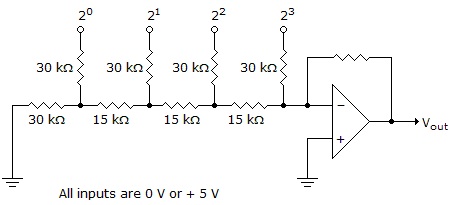Discussion
Home ‣ Digital Electronics ‣ Interfacing to the Analog World See What Others Are Saying!
- Question
What is the output voltage of the given circuit if the inputs are as follows:
20 = 1, 21 = 1, 22 = 0, 23 = 0?
Options- A. ?3.115 volts
- B. ?2.8025 volts
- C. ?1.875 volts
- D. ?1.24 volts
- Correct Answer
- ?1.875 volts
- 1. A NAND gate output is LOW only if all the inputs are HIGH.
Options- A. True
- B. False Discuss
- 2. Edge-triggered flip-flops can be identified by the triangle on the clock input.
Options- A. True
- B. False Discuss
- 3. How many select lines would be required for an 8-line-to-1-line multiplexer?
Options- A. 2
- B. 3
- C. 4
- D. 8 Discuss
- 4. A(n)________ is not a functional unit of a computer.
Options- A. input unit
- B. memory unit
- C. modem
- D. control unit Discuss
- 5. A modulus-12 ring counter requires a minimum of ________.
Options- A. 10 flip-flops
- B. 12 flip-flops
- C. 6 flip-flops
- D. 2 flip-flops Discuss
- 6. Which is not characteristic of a shift register?
Options- A. Serial in/parallel in
- B. Serial in/parallel out
- C. Parallel in/serial out
- D. Parallel in/parallel out Discuss
- 7. The base of the hexadecimal system is:
Options- A. eight.
- B. sixteen.
- C. ten.
- D. two. Discuss
- 8. Hexadecimal is a base 4 numbering system.
Options- A. True
- B. False Discuss
- 9. How many inputs must a full-adder have?
Options- A. 2
- B. 3
- C. 4
- D. 5 Discuss
- 10. In a negative logic system, a high is represented by 0.
Options- A. True
- B. False Discuss
More questions
Correct Answer: True
Correct Answer: True
Correct Answer: 3
Correct Answer: modem
Correct Answer: 12 flip-flops
Correct Answer: Serial in/parallel in
Correct Answer: sixteen.
Correct Answer: False
Correct Answer: 3
Correct Answer: True
Comments
There are no comments.More in Digital Electronics:
Programming
Copyright ©CuriousTab. All rights reserved.
